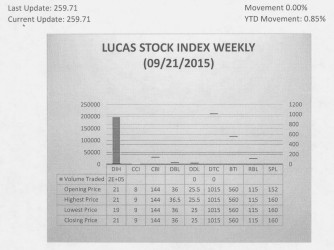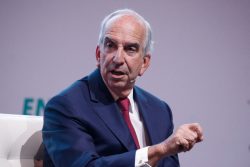Controversy
The experience with the Berbice River Bridge and its relationship with the investment made by the government seem to make people leery about using the public-private partnership investment model in the construction of projects in the future. Indeed, it is amazing that the public-private partnership model, an instrument for bringing public  interests and private money together, could generate more controversy than cooperation as is the case with the Berbice River Bridge. The model seemed also to be what was planned for the Marriott hotel and the Amaila Falls hydropower complex. There is a fear the controversy surrounding the toll for using the Berbice River Bridge might diminish the availability of the public-private partnership as an investment option in future projects in Guyana. One must ask the question, should one bad apple be allowed to spoil the barrel? In previous columns, this writer has shared the reasons governments use the public-private partnership. What has not been done before is to identify the many forms that the public-private partnership can take and the impact each has on the public interest. This article essentially tries to identify and discuss the major forms of the public-private partnership or the P3, as it is often referred to in publications.
interests and private money together, could generate more controversy than cooperation as is the case with the Berbice River Bridge. The model seemed also to be what was planned for the Marriott hotel and the Amaila Falls hydropower complex. There is a fear the controversy surrounding the toll for using the Berbice River Bridge might diminish the availability of the public-private partnership as an investment option in future projects in Guyana. One must ask the question, should one bad apple be allowed to spoil the barrel? In previous columns, this writer has shared the reasons governments use the public-private partnership. What has not been done before is to identify the many forms that the public-private partnership can take and the impact each has on the public interest. This article essentially tries to identify and discuss the major forms of the public-private partnership or the P3, as it is often referred to in publications.
Policy goals
The P3 is thought to be driven by governments because they are the ones that come up with the policy goals to be met from public projects. The idea of the project usually starts with public officials who seek to achieve policy goals that are intended to serve the public at large. These are projects in the parlance of public expenditure that provide benefits which are common to all Guyanese. Some persons might get more benefit out of the project than others, but generally the project is capable of serving all persons. For example, though persons in Berbice might use the bridge more often than persons in Region 1 or Region 9, the bridge is available for use by residents from any of those communities whenever they need to do so. Once the government decides on the project, it then looks for ways to fund the project. The P3 is a generic concept that is used to describe several types of cooperative relationships between the government and the private sector in the acquisition of public assets with a long life span. They offer financing options to a government as a means of meeting its public policy goals or objectives.
Substantive discussions

The Lucas Stock Index (LSI) remained unchanged during the third trading period of September 2015. The stocks of one company Banks DIH (DIH) were traded with 198,520 shares changing hands. There were no Climbers and no Tumblers.
Like so many things, we often fail to have substantive discussions about initiatives to ensure that there is sufficient understanding about their benefits and consequences. The model has benefits and risks and deserved some open debate before being adopted as what now appears to have been the preferred capital investment model for public projects by the previous administration. In countries far more familiar with the public-private partnership model, similar experiences have left many wondering if members of the private sector use the mechanism to gain political power without having to seek elective office. This is a bone of contention among taxpayers who regard the practice of creating public authorities through public-private partnerships as ‘overhead democracy.’ Despite such observations, the P3 model is not necessarily a bad model. The question is always the motive or purpose for using the model.
Reason
The reason cited most often for the use of the public-private partnership is the lack of funds by the public sector to carry out the many public works that are needed to keep the wheels of industry going and to meet the consumption and leisure demands of households. When governments alone have to undertake the public investment, it turns to taxpayers to raise money or to capital markets or bilateral and multilateral lenders to borrow the funds. Raising revenues to meet many deserving needs that compete with each other is not easy. Taxation means shifting money from potential private investment or consumption to public use, and it encounters resistance when taxpayers feel overburdened and they cannot see the benefits to themselves.
Another reason proffered for using the public-private partnership is to acquire access to valuable human resource skills that otherwise might not be available to the project. The assumption here is that the private sector would make its best human resources available to the government for participation in the production and management functions of the project. The anticipated outcome is a more efficiently run operation that returns a higher welfare benefit to Guyanese.
Another reason that governments use public-private partnership is to increase efficiency and use available resources more effectively. The efficient use of scarce public resources is a great challenge for governments. They have very little incentive to structure their investments to produce efficiency and effectiveness. Private operators enter the deal with the aim of achieving maximum profits. This should be accompanied by increased efficiency in the investment. It should also lead to efficiency in the operation of the bridge. An increase in the efficiency of the operation of the bridge should also lead to access at affordable prices. Even in situations where the private sector is given control over the project, the government exercises oversight and supervision. This approach should result in a lower outlay for the government.
Types of P3
There are generally five types of P3 investment options for new assets. One is the build-own-operate and transfer model. Under this method, the private sector provides the financing and builds the facility. In exchange, it gets to own the facility which could be for a fixed period of time or for perpetuity. The key feature of the BOOT model is that the investor is expected to bear the bulk of the financial risk and in exchange gets to enjoy the returns from the investment. The Amaila Falls hydropower project was presented as a BOOT but the details showed that the government was putting up equity and would have been a borrower in the loan arrangements. At the same time, the government was giving up full control of the project to Sithe Global, the intended partner.
Another type of P3 investment model is the turnkey project. This type of project is one in which the government provides the financing but has the private investor design, construct and operate the facility for a specified period of time. An important feature of the turnkey project is the performance expectations of the government. A third type of financing is the build, transfer and operate model. Under this model, the private investor finances the construction of the asset, builds it and then transfers the ownership to the government. The government then turns around and leases the asset to the private investor for a period of time. A fourth type of P3 model is the one described as the operate and maintain model. In this instance, the government would contract with a private company to operate and maintain a public asset. It is perhaps the simplest of all the types of P3 models. Finally, there is the lease-purchase model. Under this model, the private investor designs, finances and builds the facility. The investor then turns around and leases the asset to the government while maintaining control over it.
Guyana experience
In looking at the Guyana experience, the selection of the financing option is not as straightforward as one might think. From the point of view of the lender, concerns about creditworthiness and the ability to repay the loan would arise. The lender therefore has to be satisfied that there was a way to recoup the financing that he or she provides. They seek control of the project and use it as a form of collateral. From the point of view of the government, the issue might take far more than questions of loan repayment and cost-benefit valuations. The choice of method of financing could involve political considerations as well. Loans from bilateral and multilateral sources could come with some measure of control which a beneficiary government might not like. One must wonder if this was not a prime reason of the previous administration for using this model of investment in public projects. It had an opportunity to dictate who would benefit from the investment without having to worry about public accountability.
Secrecy
The Guyana experience however shows that competition, risk-sharing, and transparency must be important parts of any public-private partnership. Competition helps to reduce costs and to facilitate a more rational allocation of resources. But this is very difficult to achieve. In fact, most experts feel that competition and bias in the selection process are major weaknesses in the P3 model. Risk-sharing reduces any potential loss that taxpayers might experience from project delays or cost overruns. Transparency keeps the public informed of the nature, scope, risks and benefits of the project. People feel comfortable with market-type projects when they have full information about what is taking place. To the extent that public-private partnerships are supposed to be market oriented, then the public should be kept informed. As one thinks of the secrecy that was initially behind the Amaila Falls project and now the Marriott Hotel project, it is hard to feel that transparency is among the reasons that the previous administration favoured this model of procurement.
Aid taxpayers
Whatever the motive and the experience, there is a need to keep an open mind towards the P3 model of investment. Capital markets are not fully open to Guyana and Guyana is moving out of the income range that would qualify it for concessional multilateral loans. Consequently, while there are risks with the model, it has advantages which can aid taxpayers of this country.








